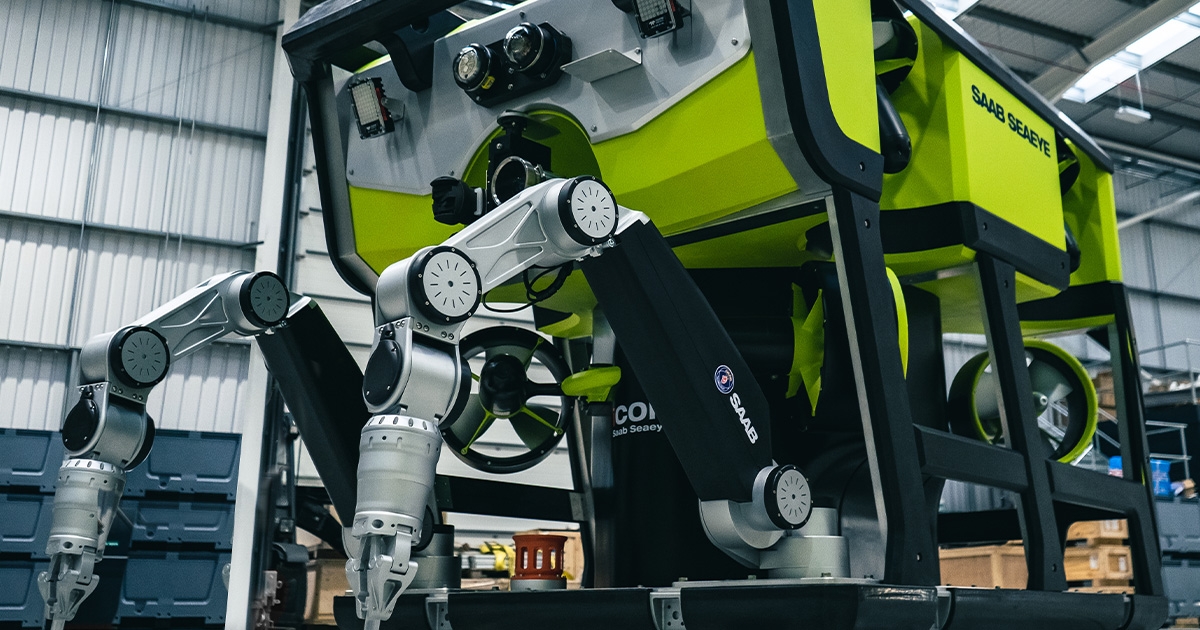Full Green Ahead for Subsea Robots

As the world transitions to greener energy solutions, electric underwater robots are ideally placed to support the oil and gas industry’s transition towards a sustainable future, whilst also helping advance the widening range of burgeoning renewable energy enterprises.
Intrinsically, electric robots are ‘green-ready’ and in harmony with the transition towards green energy that will continuously evolve through constant innovation and adaptation.
Electric is the future for sustainable underwater operations. Electric technology offers significant growth in onshore controlled operations where vehicles can operate from subsea docking stations or lightly manned or unmanned vessels, and where all-electric robots offer the reliability and reduced maintenance needed for long-term deployment underwater.
Faced with a wide range of energy producing sectors and carbon managing systems, each with their particular operational challenges, intelligent and flexible robotic systems offer increasingly higher levels of operational capability, reliability and maintainability.
EFFICIENCY IS POWER
Easy to operate and maintain, more agile and responsive, acoustically quieter, and environmentally cleaner with minimal oil, electric robots have long been in the forefront of sustainability. Their sheer efficiency means they pack in more power, intelligence, and functionality for their size which alone saves CO2 emissions and costs.
For operating in the renewables sectors, including wind, wave, and tidal energy, along with newly emerging sectors such as floating solar arrays, powerful, low-profile, highly maneuverable robots can master the strong currents and turbulent waters typical of the shallow waters in these sectors.
REMOTE, RESIDENT, AUTOMATED
All market segments can benefit from savings in sustainability and operating costs by increasingly automating the inspection and maintenance of submerged structures and their surroundings.
Key to achieving this is remote-control from onshore command centers where robots are deployed from resident seabed docking stations, or from lightly manned, or unmanned vessels, resulting in a considerable reduction in the environmental cost of support vessels and crew transfers.
Making this possible are significant advances in underwater technologies, led by key breakthroughs such as the Sabertooth, the world’s first and only roaming and hovering autonomous vehicle with added ROV functionality that allows fully flexible dual operations from a single platform. The system also demonstrates that robot systems can operate from a subsea docking station for charging and mission control.
This innovative development makes residency viable and greener subsea undertakings possible.
It also heralds a future where the notion of ROVs and AUVs will cease to exist to be replaced with transformative robots that can roam, hover, reside and perform all underwater tasks remotely, and automatically.
Towards that goal is a new generation of powerful electric work vehicles.
Power matched to hydraulic systems, full-size electric work vehicles such as the Seaeye eWROV, are more agile and more eco-friendly.
Designed for onshore control from both offshore resident locations and unmanned vessels, these ultra-capable and flexible, powerful electric work robots will play an important role in future autonomous vessel fleets that will empower progress towards a greener future.
Able to remain at sea for long durations, such systems can operate in either manual or supervised autonomous mode with human oversight and flexibility in-built for increasing levels of autonomy and automation as technology evolves over time.
SYSTEM RELIABILITY
Electric robots have a long-proven reputation for reliability. They are trusted to perform in challenging and hostile conditions consistently—even in the highly corrosive environment of nuclear storage ponds.
Whilst on mission electric robots must provide clear and enhanced information to operators, while independently managing each device on the vehicle, including auto redundancy that can keep the vehicle working even if faced with multiple equipment damage.
Continuous comprehensive internal monitoring provides system reliability with predictive indications to assist with pre-emptive maintenance planning, allowing for longer-term remote deployment underwater.
TOOLING ADVANCES
To match the potential offered by robotics to advance the sustainability offered by autonomous and remotely operating robots, tooling resources must meet the challenge. Such developments in robotic engineering include the pioneering electrification of tooling. The Seaeye eM1-7 is an example where an all-electric work-class manipulator has been created, power matched to hydraulic, but is more reliable and dexterous as each joint has a smart distributed microprocessor for intelligent, intuitive and precision arm control.
Tooling trending towards an all-electric future is creating partnerships to develop industry standard tooling and ancillary systems aimed at innovative solutions for electric robotic vehicles.
POWERING THE FUTURE
Sustainable power sources are in development to harness natural energy, such as wave and tidal current systems. Efficient electric robots are ideally suited to harnessing these new power sources.
Such solutions are important for eco-responsible power and essential for providing charging to resident systems thereby substantially reducing the number of supply ship vessels at sea and the risk to human life.
For more information, visit: www.saabseaeye.com.
This story was originally published in ON&T Magazine's May 2023 Issue. Click here to read more.

